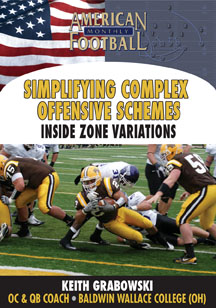 SAVAGE STORM INSIDE ZONE (Part I)
SAVAGE STORM INSIDE ZONE (Part I)
By Chad Speer, Offensive Coordinator
Southeastern Oklahoma State
On behalf of Southeastern Oklahoma State University, our coaching staff and players, I would like to thank American Football Monthly for the opportunity to submit this article. I would also like to thank our Head Coach, Bo Atterberry, for entrusting the offensive side of the ball to myself and our offensive coaches. Over the last four seasons leading the offense at Southeastern Oklahoma we have been blessed with some great players. Over that span we have broken 34 school records, had the leading rusher in school and conference history, and had the leading reception leader in school and conference history. This past season we averaged 5.3 yards per carry, with two running backs that rushed for over 1,000 yards and ended their careers with over a combined 6,000 career rushing yards.
For our offense, the objective with our inside zone is to create horizontal stretch along the line of scrimmage. We want to get the defensive line moving lateral. Up front, we are trying to get a “body on a body” as we like to call it. Once we do that, we give the running back an aiming point of the first defender outside of the playside OG and let them go to work.
 The footwork for the OL is the same across the board for all five guys. They all should take a 6 inch “zone” step or lateral step. We do not want to gain any ground, but we do not want to lose any ground either. They should focus on keeping their shoulders square to the line of scrimmage.
The footwork for the OL is the same across the board for all five guys. They all should take a 6 inch “zone” step or lateral step. We do not want to gain any ground, but we do not want to lose any ground either. They should focus on keeping their shoulders square to the line of scrimmage.
The footwork for the running back is very similar to that of the OL, but will vary slightly depending on if we are under center, in the pistol, or in the gun. If we are under center or in the pistol, the RB’s should take a 6 inch zone step with his playside foot, then get downhill with his second step. If we are in the gun, the RB will take more of a 45 degree step with his playside foot to get across the QB to the mesh point. If we are in the gun, we are more than likely reading the backside end in a spread formation. The biggest key for the RB is to keep his shoulders square to the LOS until he makes his cut.
The rules for our inside zone, much like all of our run schemes, are very simple and to the point. We like to have distinct rules and not have to adjust them to different defenses. Our basic zone rule is covered block man, uncovered team read with the next man playside. Anytime you are covered by a backside shade, you treat yourself as uncovered. A team read is a two for two block that is executed between a covered guy and an uncovered guy. The uncovered guy is always stepping to the covered guy, reading the near knee of the defender. If the near knee comes to the uncovered guy, he overtakes him and the covered guy climbs to the LB. If the near knee stays or goes away, the uncovered guy climbs to the LB.
We also have a couple of other rules within our inside zone scheme. Anytime there is a B gap defender backside, we will fold block on the backside with the OG and OT. The OG will still take his zone step to protect against the slant and then will seal the defender off. The OT will pull around the OG up to the backside ILB. We do this to help create a backside cutback lane for the RB. Versus a 3-man front, the backside OT will always base the DE. Depending on the variation we are running (Zone, Read, Lead), it will effect the TE’s or FB’s responsibility while it keeps the OL rules consistent.
